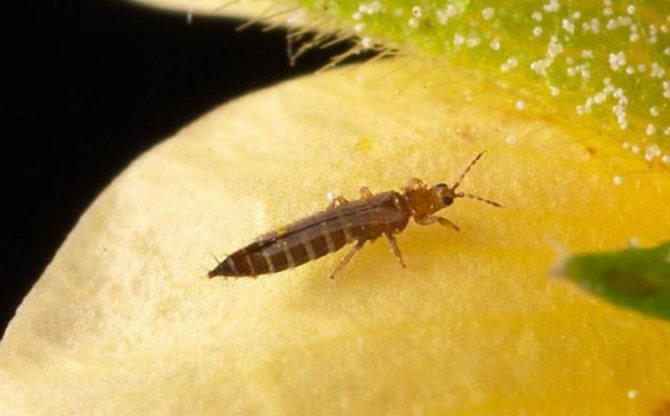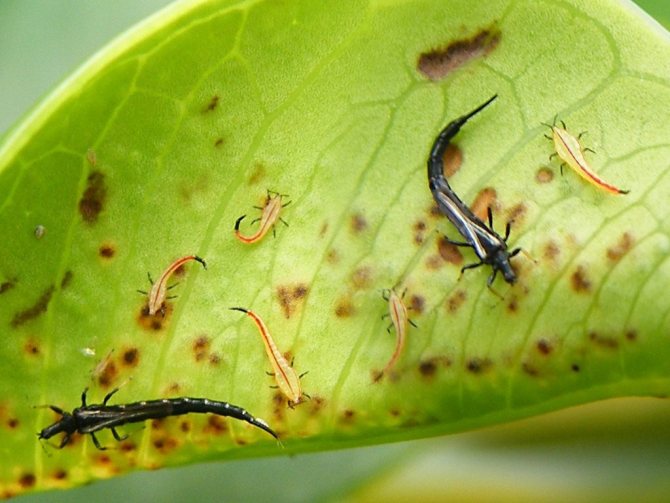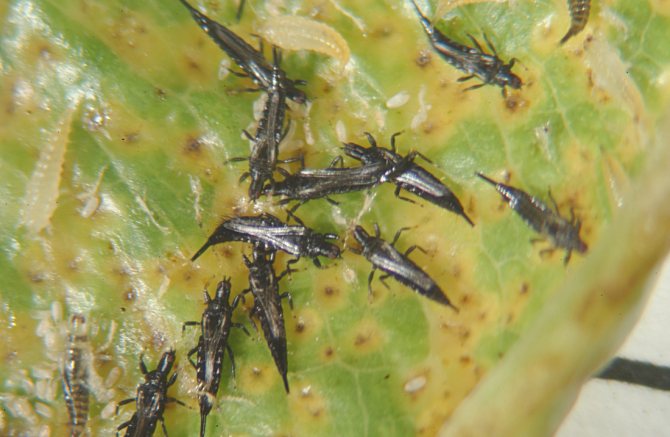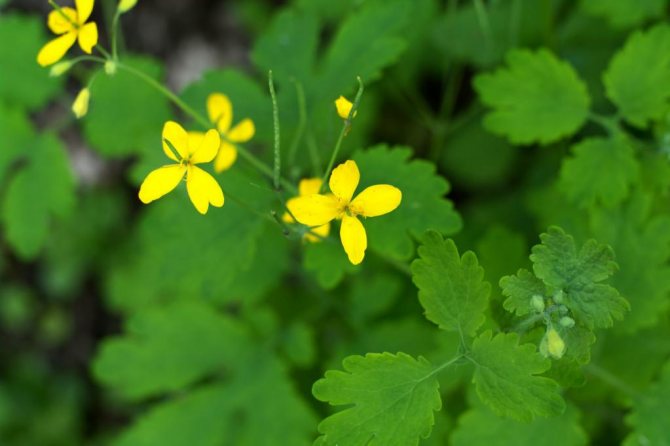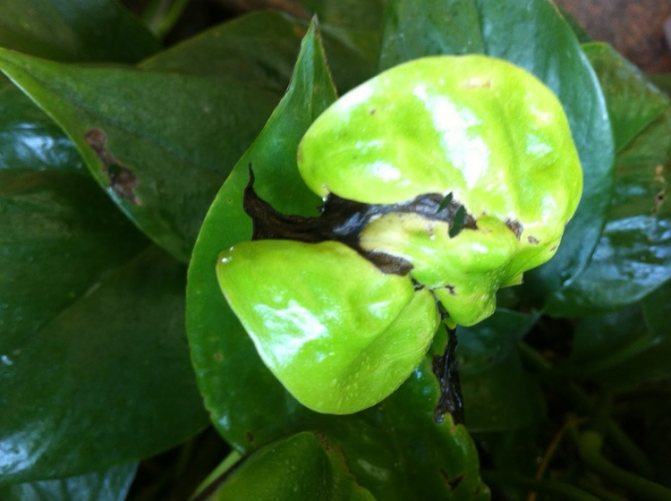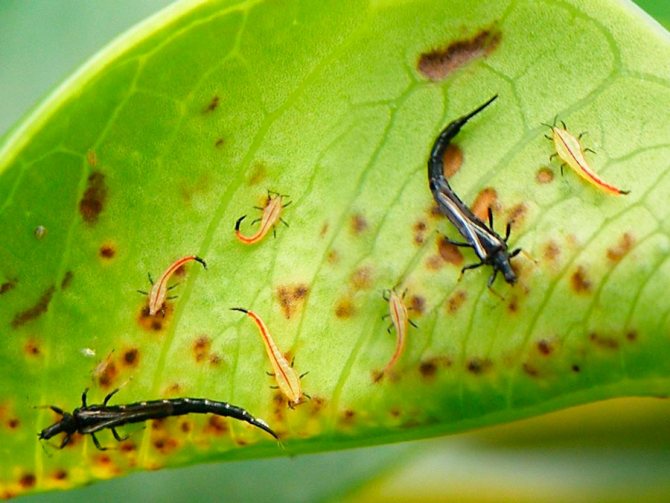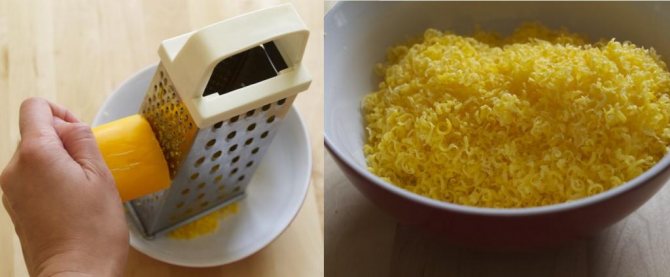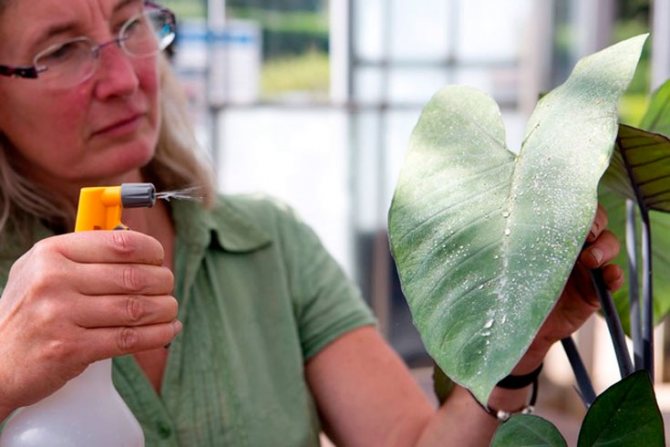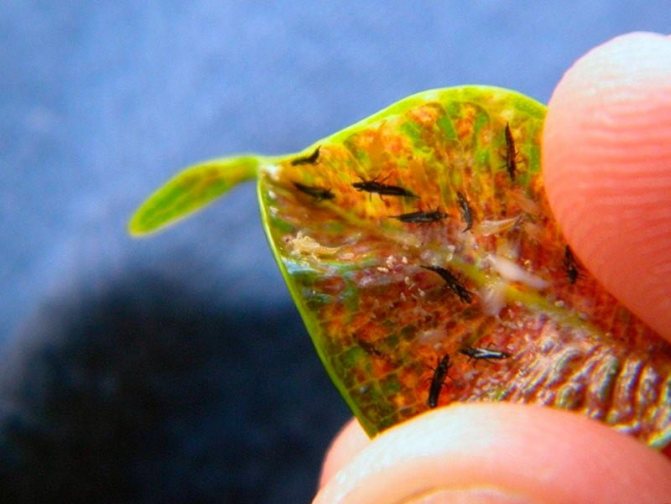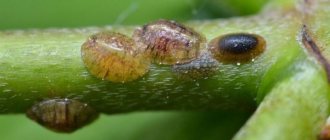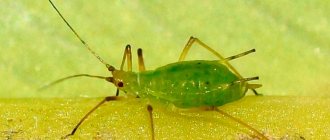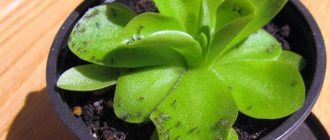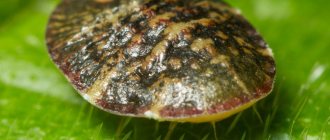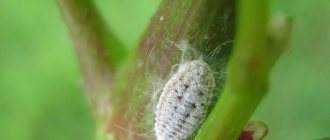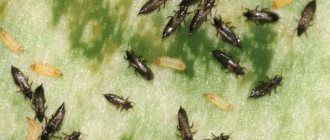Houseplants decorate our home and make it cozy, but sometimes parasitic insects appear on them, which are able to destroy a favorite flower. If you do not immediately detect them, but when pronounced signs appear, then it will be much more difficult to cure the plant. Therefore, experts advise to regularly examine indoor plants for the detection of parasites or various diseases. The most affected are violets, orchids, petunias, pelargoniums, etc.

Thrips on indoor plants
It is easy to see thrips, because the body, although not large, only up to 2-3 mm in length, has a black or brown tint, which is noticeable on a green leaf. The larvae are light yellow and very tiny, up to 1 mm in length. Thrips are mobile and can move from one plant to another by jumping or short-term flights. Females look slightly larger and wider in size.
Insects feed on plant sap, causing irreparable harm to them. They can settle both on leaves, trunks, and on buds and flowers. By disrupting the supply of nutrients, cells are gradually dehydrated, dry and die off. Another feature of thrips is their rapid reproduction. After 10 days after laying the eggs, larvae hatch from them, which then grow for a month to the size of an adult.
Prevention of plant infection
Maintain a constant high humidity. This is an ideal prevention and protection against thrips at any time of the year. In indoor conditions, if possible, it is better to isolate plants affected by thrips from healthy ones.
Move the plants very carefully: with a little shaking, the larvae and adults easily fall from the flowers and leaves and can wait a long time for the moment to re-settle on the plants. The place where the plants affected by thrips stood should be washed well.
In affected plants in flower pots, it is also advisable to remove the topmost layer of the earth, since there may be thrips larvae.
At the time of processing, it is highly desirable to remove all peduncles and affected leaves on the plants. It will take three to four treatments at intervals of 7-10 days. When treating houseplants for thrips, you can use a large plastic bag.
Place the pot with the plant in it, sprinkle and close the bag tightly for 2-3 hours. This method is also good in the fight against spider mites. The only way to get rid of thrips is to carry out a series of treatments with systemic insecticides, for example, phytoverm, actellik (the safest for use at home).
A combination of higher concentrations with a slight addition of a flea shampoo is quite effective. In the fight against thrips, a new drug, spinor, which is an insecticide of natural origin, has proven itself highly. Spraying with a spinor is carried out strictly according to the instructions with an interval of 7-10 days.
It is easier to prevent thrips from appearing than to get rid of them later. Therefore, indoor plants need to be inspected frequently. Most often, flower thrips appear with insufficient soil moisture
Therefore, it is important to regularly water and spray the flowers.
The soil for them, collected independently, must be sterilized, since the larvae of these pests can be in it.To do this, you can use special drugs "Nemabakt" or "Antonem-F".
An insect can get into a house with any flowers: purchased in a store, collected in a field or in a country house. Therefore, in this case, it is better to put the bouquet or pot separately from other plants. It is better to transplant the purchased flower into another land and into a clean pot.
»Alt =» »>
In apartments located on the lower floors, thrips can fly through an open window. To catch insects that have accidentally entered the house, you need to hang up special bright sticky traps. It should be borne in mind that adults move very quickly, and the larvae can live outside the plant for a long time.
In order for indoor plants to always delight the owners with a healthy and blooming look, it is necessary to pay more attention to them. Regular water treatments will help prevent pest infestation and save a person from long-term insect control.
Conclusion
The joy of growing houseplants in your home can be overshadowed by pests. This is especially true of thrips, the larvae of which can cause serious harm to flowers. Therefore, the first thing every florist should know about is by what signs it is possible to identify these pests.
It is equally important to know what methods of struggle can be used to destroy them.
Prophylaxis
If you do not buy land for planting flowers in a store, but dig it yourself, for example, from the same garden, it must be disinfected, for this, treat it with such means as Antonem-F or Nemabakt. Do not forget that periodically plants are required for watering so that the earth does not stand dry, and also loosen.
Purchased flowers or those brought from the garden can also be carriers of these pests, so place them away from indoor plants.
To scare off parasites from plants both in the garden and in the apartment, you can use strong-smelling flowers. For home flowers, you can prepare an infusion of such plants as celandine, marigolds, tobacco. And on the plot in the garden, where you notice the appearance of these insects, just plant the same plants, they will help not only in the fight against thrips, but also with many other pests, for example, ants.
Damage to plants by different types of thrips
The body of the pest is elongated, up to 2 mm, the color varies (usually nondescript - light yellow, dark brown or black). Adults have 2 pairs of narrow wings with long hairs. Depending on the type of thrips, the length of the wings is different, some of them are absent. The head has antennae, consisting of segments (on average - 9 segments). The oral apparatus is a piercing-sucking type. The size of light yellow larvae is no more than 1 mm.
Mature individuals move very quickly thanks to 3 pairs of legs located in the thoracic region. Each foot has 1 prong and 1 suction bladder.
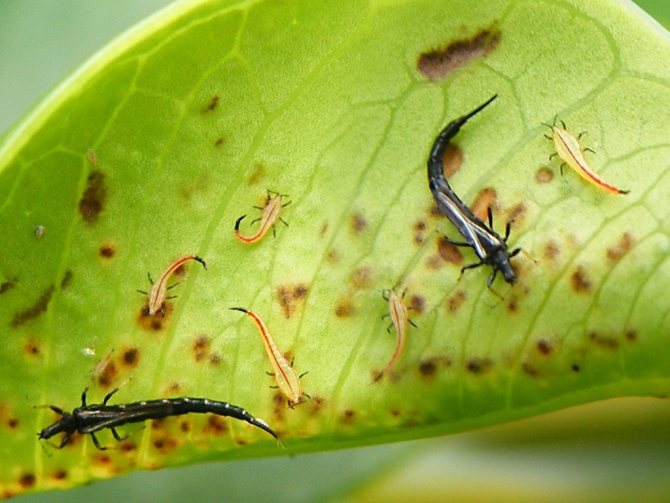

Thrips
They reproduce actively, they are able to double the size of their population in 4-6 days. Eggs are laid in flowers and leaf tissue. The offspring hatch after 10 days. The larva develops into an adult insect in 1-2 months. Due to such a short development cycle, some species are able to produce several broods during the year.
These pests have the habits of social insects. Like ants and termites, they work together to guard their laid eggs. In addition to sucking out juice, thrips carry all kinds of viruses that are dangerous to plants.
It is rather difficult to recognize belonging to a certain species, since the parasites are small and species variability is very common in them.
Common types of thrips that harm ornamental plants:
| Name | Body length | Color | What amazes |
| Western floral or California floral | 0.9-1.2 mm | Pale yellow to dark brown. The bristles on the body are dark, the wings are light yellow. | Carnations, gerberas, gypsophila, pelargoniums, roses, saintpaulias, chrysanthemums, cyclamens and cineraria |
| Tobacco | 0.8-1.2 mm | Females are light yellow, sometimes dark, antennae and legs are grayish, wings are yellowish, sometimes light gray-yellow. The color of males is slightly lighter | Solanaceae, Umbelliferae, Buttercup, Rosaceae and Liliaceae |
| Decorative | 1.1-1.7 mm | The female is yellow, then turns brown and black. The wings are darkish, with light spots at the base and on the tips of the wings. Males are lighter | The crassul (money tree), orchids and palms are especially damaged. This pest can destroy monsters and dieffenbachia |
| Bulbous | 1-2 mm | Dark brown | Common onion, as well as onion scales of various types of lily plants |
| Rosanny | Up to 1 mm | Brown | Flowers of rosaceae and some other plants |
| Palm | 0.8-1.4 mm | Bright yellow, almost transparent, with blackish bristles. Head and legs are light yellow | Solanaceae, different types of orchids |
| Dracene | About 1mm | Yellow-brown | Dracaena, hibiscus and ficus |
| Variegated | About 1mm | Dark brown | Flowers and ovaries of ornamental plants |
Description of thrips
Eating juices, thrips reproduce quickly and just as rapidly lead to significant damage to the green part of plants.


Thrips on a houseplant
If you regularly examine the flowers, it will not be difficult to spot the insects, although they are very small.
Need to say! The pest is widespread throughout the planet, present on every continent. An amateur flower grower usually first of all sees the result of his activity in the form of damage caused to a room culture: this is a sluggish appearance, light spots on the leaves.
The greatest danger comes from the species that carry the infection:
- greenhouse;
- Californian;
- tobacco thrips.
The degree of damage depends on the duration of the insect exposure. The flowers are deformed, black and white spots appear on them. The leaf plates begin to resemble fabric. It is especially annoying to find thrips on orchids and other valuable flowers.
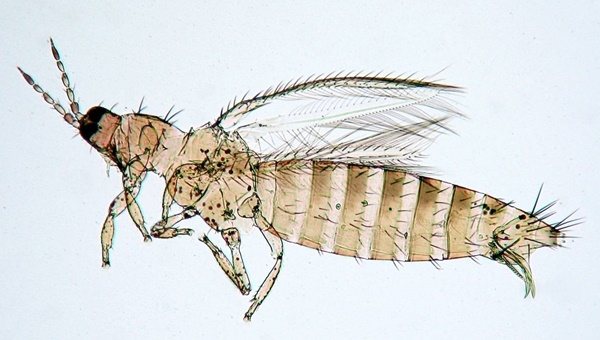

California thrips
Their description includes the following features:
- the body is thin and long;
- the size reaches 14 mm, although in common types - up to 2 mm;
- piercing-sucking mouth type;
- runs with the help of legs equipped with a tooth and a suction cup;
- nondescript, often black or gray color.
Also, individuals are equipped with small wings.
How to deal: effective methods
If thrips are found on indoor plants, it is necessary to take measures to destroy them as soon as possible.
General rules
To identify in which vases the thrips have started, it is recommended to place sticky traps around their perimeter. Infected flowers should be isolated to avoid contamination of other plants. It must be transported carefully so that the larvae and adults do not fall out of the pot. But for preventive purposes, it is recommended to treat all plants in the house with a weak fungicide solution.
Shower all parts of the infected plant. You can wipe the leaves and shoots with a cotton pad soaked in a solution of alcohol and water (1: 1) or tobacco infusion. Then wash off the solution and leave the plant to dry.
Remove the top layer of soil, or even better, replace it completely. Rinse the root system well. Transplant the flower into a new pot with disinfected soil. If the plant is flowering, then all flowers and buds must be cut off. Wash the location of the infected flowerpot with a solution of laundry soap and alcohol.
Chemicals and insecticides
A large number of chemicals are available in flower shops. They are able to quickly destroy parasites without harming plants.
Effective insecticides:
- Fitoverm is recommended to be used in the first place, as one of the safest remedies. Dilute 2 ml of the drug in 0.2 l of water. Process the plant. Repeat the procedure 3-4 times every 6-8 days.After spraying, put polyethylene on the flowerpot, remove it after a day.
- Confidor - dilute 1 g of the product in 0.5 liters of water. Spray the plant and soil. As a rule, insects die after a few hours. It is recommended to shed the soil with a weaker solution.
- Agravertine - dissolve 5 ml of the drug in 500 ml of water. Spray the diseased plant. Cover the pot with a bag on top and remove the next day.
- Mospilan is a powder that is diluted in water (2.5 g per 1 liter) to obtain a solution. Water the flower and spray it.
- Aktara is a powerful complex insecticide. To spray the plant, dilute 1 g of the drug in 1.25 liters of water, for watering the soil 1 g per 10 liters. The optimal number of procedures is 3-4. The frequency of spraying is once every 10 days.
- Actellik is a drug that is used for severe damage to flowerpots. Dilute an ampoule of 2 ml in 1 liter of water. Spray the plant and put a bag on top for 1 day. The product has a pungent odor, so processing can only be carried out outdoors.
Chemicals are effective if the air temperature in the room is not lower than + 18 ° C, and preferably + 25-26 degrees. Otherwise, the processing may not bring the desired result. If thrips are not destroyed after 2 procedures, it is worth replacing the drug. It is possible that insects have developed resistance to active substances.
Safety measures when working with chemicals:
- Use insecticides strictly according to the instructions on the package.
- In summer, chemical treatment is best done outdoors, in winter in the bathroom.
- During the procedure, protect hair, respiratory organs, skin from the ingress of chemicals.
- After processing, you cannot immediately return the flowerpot to its place.
- Avoid exposure of the treated flowerpot to direct sunlight.
- If the chemical was used indoors, it should be well ventilated.
- After the procedure, wash your hands and face with soap and water. Rinse mouth with water.
Folk remedies
If the infection has just occurred, the thrips have not yet had time to breed and severely damage the plant, you can resort to using folk remedies.
Proven recipes:
- Take 50 g of dry crushed marigolds. Fold in a glass jar, pour 0.5 liters of warm water. After 2 days, strain the resulting infusion. Spray the affected plants.
- Grind 20 g of dry mustard leaves. Pour 1 liter of boiling water. Leave for 2 days. Before use, dilute the product with water (1 teaspoon per glass of water). Water the soil. Repeat the procedure for 3 days in a row, then every 3-4 days until the thrips completely disappear.
- Pour crushed dry tobacco (100 g) with hot, but not boiling water (1 l). Insist for a day and strain. Dilute the resulting infusion with 1 liter of water. To carry out processing 1 time a day in the morning only the ground parts of the infected plant.
- 50 g fresh celandine or 100 g dry pour 1 liter of water, boil for 5 minutes. Leave to infuse for 10-12 hours. Strain the product and process the plants.
Indoor cultures are treated with decoctions and infusions in the morning.
Folk methods of struggle
Foam - mainly suitable for palm and ficuses. Plants with delicate leaves may not survive this approach. Use household, potash or tar soap. The most effective flea shampoo for animals. Sometimes a detergent is used. You need to process not only the plant, but also the place where it stands. The pot is outside. By adding ammonia to the solution, you can enhance the effect. The processed copy must be covered with foil and left overnight. When using rubbing alcohol, it is important to rinse the green pet out 10 minutes after applying the mixture.
Sticky Trap - Available at many stores. These are fly tapes and similar devices. Practice shows that yellow traps are most effective. It is important that the trap will trap all insects, not just thrips.
Garlic infusion - The smell of garlic is believed to irritate and kill the thrips.It is enough to take a couple of large cloves, crush them and insist in a glass of hot water for about a day. Then spray the plant with the resulting solution and wait for the result. There is a simplified option - to scatter finely chopped garlic at the base of the stem, cover it and let it stand for a couple of hours.
Preventive measures
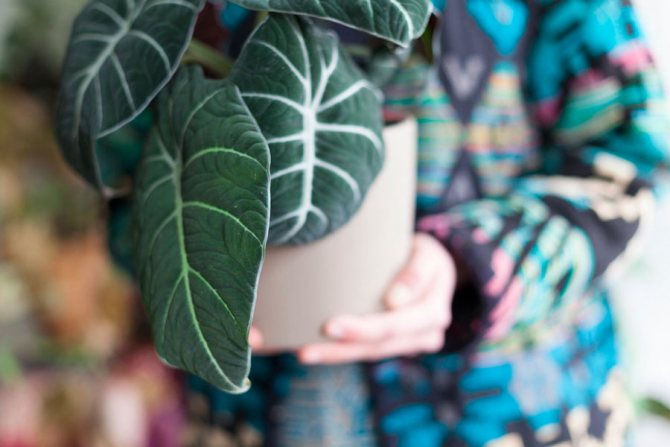

It is easier to prevent any disease than to cure it later. The same rule applies to house plant pests. To get rid of or prevent the appearance of parasites in the apartment, who want to profit from the juice of indoor flowers, it is enough to arm yourself with a number of rules and recommendations. For example:
- If it has already been decided that the apartment contains houseplants, then it is necessary to take proper care of them. Caring for them also consists in inspecting the flowers every day for traces of the vital activity of pests such as thrips.
- Thrips can appear in conditions of insufficient watering of plants, when the soil dries out.
- Pests can enter the apartment with a new flower purchased from a flower shop. It is better to first determine it in a hotel place and check whether pests have begun to multiply.
- Since thrips have wings and can fly, they can easily enter through an open window. Not always mosquito nets can protect the premises from these parasites.
- If you regularly process indoor plants with infusions of celandine or tobacco, then these simple procedures can scare away uninvited guests.
The rules are not at all complicated, it is enough to be patient and understand that ignoring these simple rules can lead to a negative result. Moreover, if it is not possible to timely detect pests on plants, then you will have to make every effort to save a flower or an ornamental plant.
How to get rid of thrips
Thrips are a serious opponent. And it can be difficult to defeat them, especially in the conditions of large greenhouses. Insects multiply quickly (they can double their numbers in a week) and develop immunity to the drugs used against them.
During the initial infestation phase, give the plants a warm shower and quarantine them. Hang up glue traps. For more serious infestations, there are various methods for treating plants from these pests.
Fumigation checkers
In greenhouses and greenhouses, plants infected with thrips can be fumigated with tobacco sticks. Smoke containing nicotine kills larvae and adult insects and does not harm, and even promotes plant growth. The treatment must be repeated after a week, because fumigation does not affect thrips eggs.
What is a tobacco checker and how to use it There are three useful properties of an insecticidal agent - a tobacco checker. What are its features, and how to apply it? Let's figure it out.
It is possible to fumigate greenhouses from pests with a sulfur stick only after harvesting.
Application of insecticides
To control thrips on indoor plants, apply a series of systemic insecticide treatments. Fitoverm is the safest for home use. Spray the plant with the prepared solution (2 ml per glass of water). You can also water it at the root. After the procedure, put a plastic bag on the plant, remove it after a day.
In greenhouses, greenhouses and open ground, insecticides such as Alatar, Aktara, Iskra and others can be used. Spray the plants and the soil under them with their solutions diluted according to the instructions. The treatment must be repeated after a week.
When choosing a drug, pay attention to its active ingredient. Alternate active ingredients, because
thrips quickly develop immunity to the drugs used against them.
Folk remedies
Folk remedies help with minor damage to plants with thrips.To combat them, decoctions of creeping mustard, yarrow, real tobacco, large celandine are used.
You can spray with infusion of garlic and dandelion. Soak 1 kg of dandelions in 10 liters of water, after two days add 4-5 chopped heads of garlic to it. After the liquid has been infused for several hours, strain it and process the plant.
Biological method
In addition to insecticides, biological control methods can be used to control thrips. Amblyseius mites (Amblyseius cucumeris, Amblyseius barken, Amblyseius degenerans) have proven themselves well.
They are released on plants, and they immediately begin to look for larvae. One tick eats two or three of them a day.
Thrips and predatory bugs Orius laevigatus, Orius majusculus hunt for thrips.
The best way to protect plants from thrips is, of course, prevention. Therefore, regularly examine the "green pets" and take timely measures. Remember that over-watering and too dry air will breed these pests. Therefore, provide the plants with proper care and air humidity, and then thrips will not be afraid of them.
The main signs of fringed wing infestation
Thrips at various stages of development can harm the plant. Adult insects and larvae feed on cell sap. Discolored marks appear on the surface of the crops. In the future, the points acquire a yellow color. Patterns are formed in the form of stripes and strokes. After a few days, the spots will merge.
The affected tissue begins to fade. Holes appear on the plant. The culture completely loses its foliage. The production of inflorescences ceases.


Plant leaves damaged by thrips.
Massive colonies form zones with a silvery sheen on the plant. Shoots can bend. Damage to the buds of flowers leads to deformation of the inflorescences. Thrips leave excrement in various areas.
After the appearance of thrips, the culture can suddenly develop a severe viral infection. Almost all subspecies of fringed winged animals are polyphages. Insects are capable of destroying all parts of the plant.
Types of thrips
Since thrips are very small in size, not everyone always understands what kind of insect settled on their site, but it is advisable to take a closer look and still find out which thrips infect your plants, firstly, this is necessary for what kind of danger your plants are in. plants, since some species are especially dangerous. They are carriers of many infections that can destroy your plants, or species that eat fruits and foliage, and leave their secretions on them, which spoils the taste of the harvest and just simply spoils the plants.
Let's explore each species in more detail:
- The variegated thrips has a dark brown, almost black color, in size it can reach 1-2 millimeters. It mainly attacks ornamental plants, flower beds and flower beds suffer, and also settles on fruit plants. It is even more often found on the newly forming ovaries, which it eats and the plant after that is already difficult to save.
- Western flower (California) thrips - in our localities, in your garden beds, you are unlikely to meet it, so you do not need to worry, but if you are the owner of a greenhouse and noticed such thrips, then you need to start sounding the alarm and take urgent measures, since this species is taken for almost all plants, it likes fruit, vegetable, berry and ornamental crops, for example, it is found on grapes, gladioli, roses, orchids, and tomatoes. Has a light brown, wheaten color.
- Tobacco thrips - these thrips are very small in size, they do not even reach one millimeter, females and males differ in color, the first are light, golden in color, and the second have a darker, brown color. They mainly affect flowers and vegetables.They are found only in warm regions, and only in greenhouses.
- Bulbous thrips - in our country, it is one of the most common, when such an insect is found on onions or various bulbous plants, you can not even guess what kind of species it is, it is definitely a bulbous thrips. It has a dark brown color, one might even say black, and reaches two millimeters.
- Rose thrips - this type of rose lover, and therefore have such a name, they settle on the leaves and peduncles eating them. They differ in light brown color and small size (usually they do not even reach one millimeter). They can settle on both open and closed soil.
- Reiter's thrips - affects apple trees and some other fruit plants. They are similar in color to bulbous thrips, have a black tint, the size of such thrips is about 1.5 millimeters. Distributed everywhere.
Thrips of almost all species cannot fly, although they have wings, but they are too poorly developed for flight, but there is one type of thrips - Grain thrips, which are able to fly from one field to another in whole flocks.
How to get rid of thrips on indoor plants?
Realizing that your indoor flowers are already affected by thrips, you should act urgently:
- the first step is to transfer flowers infected with thrips to a separate room. However, you need to be very careful here, because during transportation, the larvae can fall off the pot and move to neighboring plants;
- remove pests from the flower by putting it under the shower;
- treat all indoor plants in your apartment with special preparations. The following institutes will help you cope with thrips: Aktara, Mospilan, Fitoverm, Intavir, etc. To consolidate the result, it is recommended to re-spray after a week;
- It is recommended to install sticky blue or yellow traps around the perimeter of the plants;
- having determined in which pots the thrips have already started, it is necessary to remove the top layer of the soil, and it is best to remove all the soil, rinse the roots and transplant the plants into the already cultivated soil;
- all parts of the plant where pests have been found must be thoroughly rinsed.
How to deal with thrips on indoor plants with folk remedies?
If you have noticed only a few larvae from thrips and the plants are not yet completely affected, then you can choose milder methods of dealing with this pest, in which folk remedies can help you:
- an infusion is made from one teaspoon of chopped onions or garlic and a glass of water. In a day, when the product is ready, plants are treated with it;
- it is necessary to take dry flowers of marigolds in the amount of half a liter jar, fill the container with water to the top and leave to infuse for two days. When the time comes, the mixture is filtered and the plants are treated with it;
- you need to take fresh dandelion leaves or roots in the amount of 50 grams, pour one liter of warm water and let it brew for three hours. After straining, it is necessary to spray the affected flower with the mixture;
- take 100 gr. chamomile, pour one liter of water and let it brew for 12 hours. After straining, 5 g is introduced into the mixture. green soap, after which the plants are treated with it. After a day, the remnants of the product must be washed off under a warm shower;
- you will need dry shredded tobacco in the amount of half a glass, which must be poured with one liter of water and put for one day for infusion. Strain the finished product and add an additional 1 liter of water. This infusion is sprayed on diseased plants;
- you need to take 50 gr. dry tomato leaves, add a glass of water and let the mixture stand for 3 hours. After straining, water is added to the infusion to bring the volume to 1 liter. After that, they spray the affected plant;
- you need to take 50 gr. fresh blooming celandine, which can be replaced by 100 gr. dry raw materials.You need to add 1 liter of water to it and let it stand for a day. Next, the infusion is filtered and the plants are processed;
- sometimes spraying may not work for thrips. In this case, alternative treatments can be used. You need to take chopped garlic or turpentine, fill a small container with it and put it directly in a pot with a diseased plant. Then put a plastic bag on top of the flower and wait for three hours.
Preventive measures
In order not to deal with thrips on the very first day after buying a plant, you need to choose it very carefully. Arriving home, he should be placed in a separate room and monitored for two to three weeks. To prevent pests from spreading to other plants in your home, you need to regularly carry out the following activities:
inspect plants regularly, paying particular attention to potential signs of pests; maintain optimal humidity in the room; keep sticky traps in the growing area of indoor plants; keep plants clean with a warm shower.
It is not always possible to completely destroy triops the first time. The fact is that after the measures taken, the larvae of this pest can remain outside the plant for a certain period of time, and subsequently can return again. Therefore, it is recommended from the very first day, when a houseplant appears in your house, to start taking preventive measures so that later you do not spend a lot of time and effort fighting these pests.
Ways to deal with thrips
Thrips are particularly persistent pests! They multiply very quickly - at optimal temperatures for them (and for many species this is just room temperature - + 20 ... + 25 ° С) they can double their numbers in 4-6 days.
If thrips are found on plants, it is necessary to inspect nearby plants, since thrips easily move to neighboring plants.
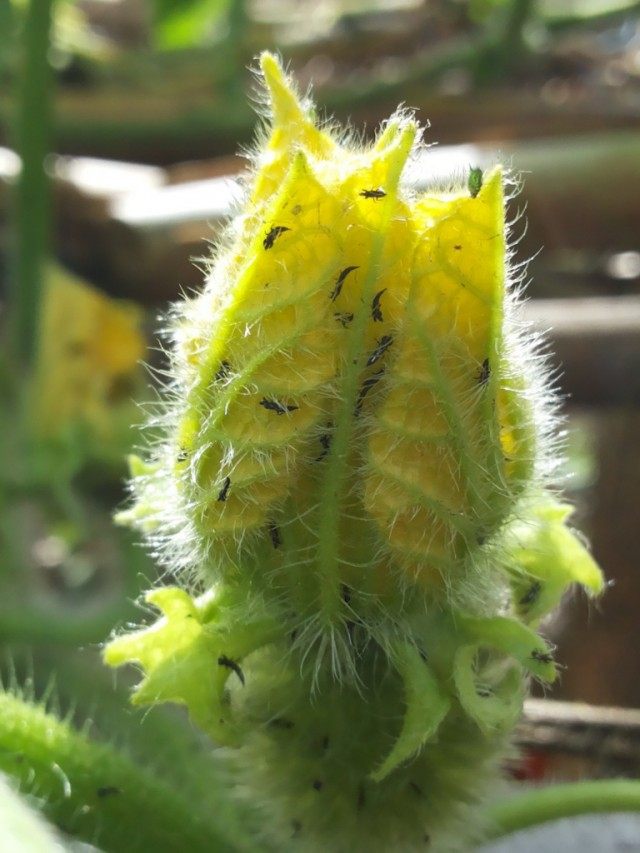

Zucchini flower affected by thrips. Scot nelson
If possible, it is better to isolate affected plants from healthy ones. Transfer the plants very carefully: when the transferred plants are shaken, thrips larvae and adults easily fall from the leaves and can wait a long time for the moment to re-settle on the plants.
The place where the plants affected by thrips stood should be thoroughly cleaned, as well as the topmost layer of potting soil from the treated plants should be removed.
Shower the plant before using an insecticide. If at the moment you do not have an insecticide, then you can wash the plant with a sponge and laundry soap, however, this is a temporary measure, and it does not ensure the removal of thrips.
Thrips control chemicals
- Fitoverm: dissolve 2 ml in 200 ml of water. Spray the affected plant with the resulting solution, after spraying, put a transparent plastic bag on the plant, it can be removed after a day.
- Vertimek: dissolve 2.5 ml of the drug in 10 liters of water. Spray the affected plant with the resulting solution, after spraying, put a transparent plastic bag on the plant, the bag can be removed after a day.
- Agravertine: consumption rate: 5 ml per 0.5 l of water. At temperatures below +18 degrees, it does not penetrate well into plant tissues. Spray the affected plant with the resulting solution, after spraying, put a transparent plastic bag on the plant, the bag can be removed after a day.
- Aktelik: dissolve the ampoule in 1 liter of water (has a very pungent odor). Spray the affected plant with the resulting solution, after spraying, put a transparent plastic bag on the plant, the bag can be removed after a day.
- Karate: consumption rate: 0.5 ml per 2.5 liters of water (in a 2 ml ampoule).
- Confidor: the solution should not be sprayed, but the substrate should be shed from the infected plant.
- Karbofos: consumption rate: 15 g per 2 liters. water (packs of 60 and 30 grams).
- Intavir: consumption rate: dissolve 1 tablet in 10 liters. water. Spray the affected plant with the resulting solution, after spraying, put a transparent plastic bag on the plant, the bag can be removed after a day.


Adults and larvae of thrips. Scot nelson
Processing must be done at least twice with an interval of 7-10 days, since larvae gradually hatch from the eggs laid in the tissue of the leaves.
Folk remedies against thrips
Various folk remedies help with small damage to the plant with thrips, but if the damage is massive, then it is necessary to apply various systemic insecticides that penetrate the plant and act already through the plant tissue on thrips.
Decoctions are used: creeping mustard, Sarepta mustard, paprika, real tobacco, yarrow, celandine.
In addition to insecticides, predatory mites can be used in the fight against thrips: Amblyseius cucumeris, Amblyseius barken, Amblyseius degenerans, predatory bugs Orius laevigatus, Orius majusculus.
Pest control problems
Before embarking on the fight against hated insects, you need to get to know them better and learn more about their biology. Great difficulty in the fight is caused by the too small size of not only young animals, but also adults. Add to this several stages of development, as well as good resistance to chemicals.


A single application of chemistry will not lead to a result - the population size will not significantly decrease. Therefore, it is unlikely that it will be possible to cope with the problem at once. To completely destroy the pests, you need to carry out several more processing sessions, at short intervals. Eggs do not die during processing. They are found in the tissue of the leaves, so it is very difficult to get them. To remove the clutch of eggs, the affected leaves are removed. Others are carefully examined for contamination.
One of the unpleasant features of this insect is its high adaptation to pesticides. They are not susceptible to most poisons used to combat other pests. Larvae are practically inaccessible. They go deep into the ground, near the roots of the plant. Therefore, it is impossible to get them there.
The fight against thrips must be carried out constantly and quite tough. Infected plant parts are removed. For treatment, it is best to use two or three times the concentration of insecticides.
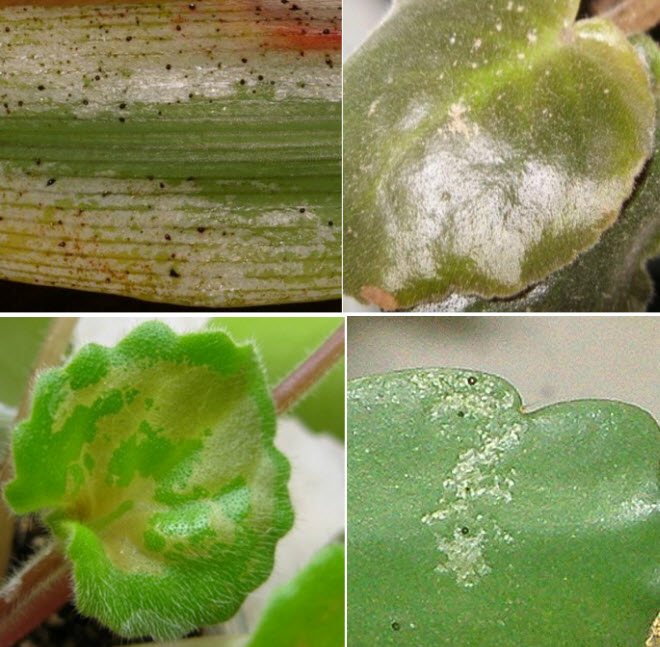

Damage caused
Unfortunately, the fact that not everything is in order with the plant is paid attention only after its appearance changes. The flower looks drooping and depressed. The grower begins to investigate the sudden illness of the flower, and discovers a colony of thrips on the underside of the leaves.
Popular: Methods to protect and rid seedlings from a black leg
Most of all you should be wary of such species ׃
- Californian;
- greenhouse;
- decorative;
- tobacco.
These varieties are dangerous in that they carry viral infections that can infect other indoor flowers.
How to find thrips on indoor plants?
If, in the process of examining indoor plants, you find that some of the leaves are discolored, and there are also many points caused by punctures on them, then this is a clear sign that thrips are bred in your apartment.
If you pay attention to the lower part of the leaves, then there you can find spots of a brownish or brown hue. Damaged areas often turn silvery, which can be attributed to air entering the cells
If, at the first signs of thrips activity, no operative measures are taken for treatment, foliage dying off, deformation of flowers and buds subsequently occurs. Insects cause additional harm by depositing sticky secretions, which are a favorable environment for the development of a sooty fungus.Although thrips are not picky about food, the most preferred houseplants for them are violets, begonias, roses, citrus fruits, orchids and ficuses.
Violets suffer the most from thrips larvae, as they destroy the flower's anther. At the first signs of their appearance, it is necessary to cut off all flowers and buds within the next 1.5 months, combining this with treatment with suitable preparations.
Signs of thrips appearance
These insects are not so easy to find, because they lead a rather secretive lifestyle, if you do not notice them in time, and only when they form a large family, it may be too late, the plants can die and it is much more difficult to fight a whole bunch. than with a small congestion.
How to determine the settlement of thrips:
- when houseplants are affected by thrips, small holes form on them, which means that they drank the juice of this plant
- discoloration of leaves or their yellowing may also be a factor in the presence of thrips, but having found only changes in the color of the leaves, you should not immediately sin on these insects, since yellowing or discoloration may occur due to other reasons.


- if the plants are affected by dark spots of a brown hue, then these are the deformations that these insects have led to, it is time to take action, otherwise the plant may die.
- if thrips begin to feed on the plant abundantly, then it will soon begin to wither and dry, and the leaves will fall off.
- The most obvious factor is the appearance of black dots on the plant and sticky secretions, here you can already be sure that your plants are occupied by thrips.
Most often, thrips appear on dry, loose soil in a sunny place, where very rarely something is watered and sprayed, since these are the most suitable conditions for their habitation and reproduction.
Now that we already know almost everything about these pests, it is time to start studying control measures, of which there are currently a lot, they need to be selected depending on who and where we are fighting, because, for example, indoor thrips are different from those what we meet in the garden, and naturally, the methods of struggle are different for everyone.
Common types of thrips
The first information about the existence of thrips was obtained back in 1744, when Karl de Geer discovered these pests. Today, a person has become more aware of the species diversity of these pests, among which special species can be distinguished that most often affect other ornamental plants:
- western (California) flower thrips. This is a tropical species that can be found only in some regions of our country. The first fact of his presence was confirmed in St. Petersburg, when seedlings of carnations and chrysanthemums were delivered there. Today it is found in several dozen greenhouses and greenhouses;
- tobacco thrips. This pest lives in the middle lane and southern regions of our country. Here it is found on various ornamental plants grown in greenhouses and greenhouses. The insect itself is small, reaches a length of no more than 1 mm, has a light yellow or brown color;
- decorative thrips. The most widespread is in the northern regions and the middle zone of our country. Threats to many indoor plants. Most of all, orchids, monstera, dieffenbachia and certain types of palms suffer from this pest. It can be identified by its dark brown color, as well as a small body, which has a length of 1.5-2 mm;
- dracaena thrips. Most often it can be found indoors in the northern regions. Hibiscus, ficus, dracaena and a number of indoor plants suffer from it more than others. The characteristic color of the pest is yellow-brown, the body is about 1 mm long;
- variegated (common) thrips. This species is represented in most of our country.The main food for him is flowers and buds of indoor plants. It looks like a dark brown insect, reaching a length of just over 1 mm;
- rose thrips. Its favorite habitats are rosaceous plants. A characteristic feature is a brown body, up to 1 mm in length;
- bulbous thrips. This species is represented in most of our country. Most often it can be found among the scales of lily plants. It can be identified by its dark brown color and body up to 2 mm long.
Dangerous pests on gladioli
Thrips are also very dangerous for gladioli. This minor pest causes irreparable damage to the plant. Its buds and flowers are especially affected by thrips.
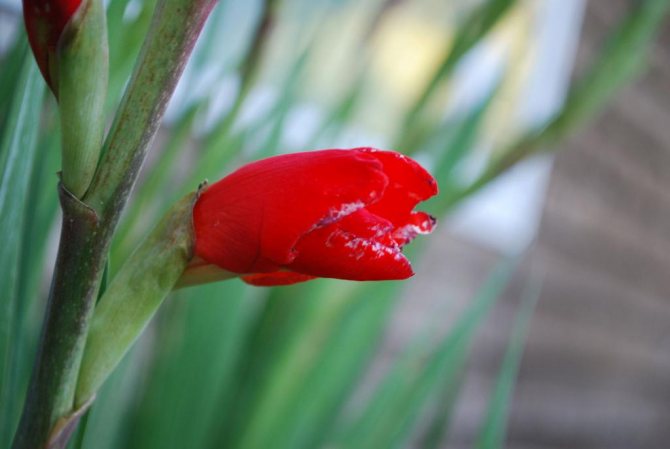

In the photo - thrips on gladioli. The fight against the pest is complicated by the fact that it is located under the scales of the bulbs.
The main damage is caused to corms, and this can happen even at the stage of storage. Close inspection of the tubers reveals crusty spots. The color of the crust is brown. The actions that need to be carried out at the first moment are the immersion of the corms in hot water heated to about +50 ° C. You can also throw out heavily infested bulbs and process healthy tubers before storing.
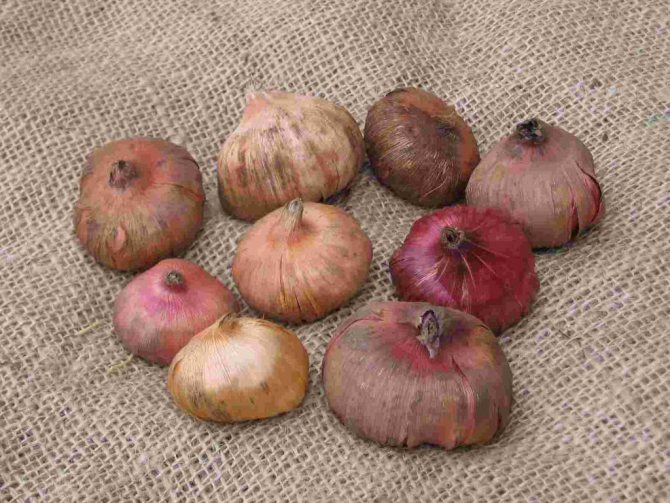

Above are the tubers of gladioli, possibly affected by thrips (pictured). The fight against them begins with prevention.
As a preventive measure, you can carry out repeated spraying with Decis solution. You need to spray absolutely all tubers: both sick and healthy. Repeat the procedure two to three times. Lovers of folk recipes can use infusion of tobacco, yarrow and celandine.
You need to start the fight against thrips on gladioli with harvesting and laying the bulbs for storage. Before putting them away for winter storage, it is necessary to treat the bulbs with the preparation "Maxim".
You need to continue to fight thrips in the spring, as soon as the initial phase of leaf growth begins. The first spraying of the plants should be carried out. Absorbable drugs are used against thrips:
- Fosbecid.
- Iskra-Bio.
- Fitoverm.
It is necessary to spray the seedlings of gladioli at intervals of three weeks.
Preventive actions
To prevent colonization of thrips, you should:
- Maintain an optimal level of humidity in the air - from 55 to 75%.
- Inspect the culture periodically. Leaves, stems and inflorescences must be carefully checked. Barely noticeable grayish or milky larvae sometimes appear on the lower part of the foliage. Small fringed wings are able to move very quickly. Sometimes you can see adult representatives with transverse stripes.
- It is necessary to regularly spray the plants with warm, settled water. Ornamental crops can be sprayed with soapy water.
- To get rid of pests, it is also recommended to purchase special sticky traps. Yellow or blue adhesive tapes are placed among the crops. Protection will help kill existing insects and prevent colonies of new parasites from multiplying.
It should be remembered that inactivity negatively affects not only the affected plant.


As a preventive measure, it is necessary to spray a soap solution on the plants.
Thrips can easily transfer to healthy crops of another plant.

